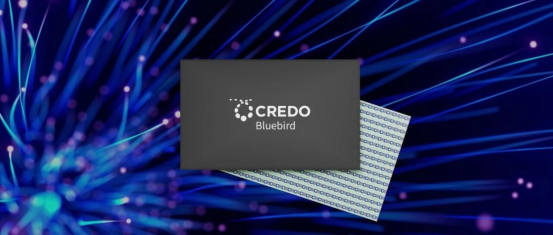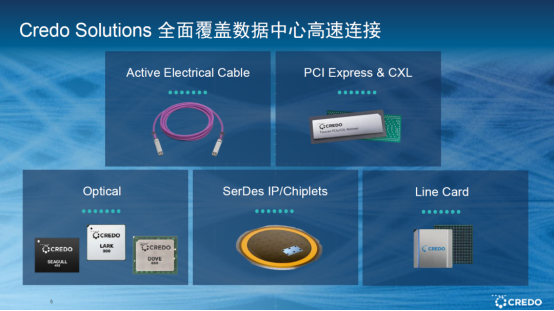Targeting the US$12.7 Billion Market! Credo Takes the Lead in the High-Speed Interconnect Race
![]() 10/23 2025
10/23 2025
![]() 443
443
The 2025 Government Work Report puts forward the initiative to continually advance the 'AI Plus' program, aiming for a better integration of digital technologies with manufacturing capabilities and market advantages. With the swift evolution of AI technology, both the scale of model parameters and computational complexity have soared exponentially. Meanwhile, cloud computing service models are transitioning from centralized systems to distributed and edge-coordinated architectures. The profound convergence of these two trends has sparked an enormous demand for data interaction, imposing unprecedentedly stringent requirements on the bandwidth, latency, energy efficiency, and reliability of data center networks.
However, numerous existing network components find it challenging to meet the transmission demands spurred by computing power upgrades, primarily due to issues such as inadequate performance and high power consumption. The industry is in dire need of breakthrough high-speed interconnect solutions. Against this backdrop, Credo Technology (NASDAQ: CRDO), a frontrunner in high-speed data center interconnect solutions, has officially unveiled its Bluebird Digital Signal Processor (DSP) tailored for 1.6 Tbps optical modules.

This cutting-edge product leverages advanced CMOS technology and incorporates proprietary innovations, delivering outstanding performance and low power consumption. It achieves an overall power consumption of nearly 20 W for the 1.6T optical module while facilitating high-efficiency single-channel 224 Gbps PAM4 data transmission. This provides vital support for harnessing the powerful computing capabilities of state-of-the-art GPU chips, effectively circumventing bottlenecks where 'high computing power is constrained by sluggish data transmission'.
Why the 1.6T Optical Module is Becoming a 'Must-Have' for Future Computing Power
The global AI computing power race is in full swing, with optical modules acting as the 'high-speed bridges' that link computing nodes. These modules are pivotal devices for establishing data transmission links, dictating the 'transmission efficiency' of AI computing power.
Data from LightCounting and Omdia reveals that global shipments of 800G optical modules reached approximately 8 million units in 2024 and are projected to surge to 18-21 million units in 2025, marking an annual growth rate exceeding 125%. Notably, higher-bandwidth 1.6T optical modules are also rapidly gaining market traction, with shipments expected to climb from 2.7 million units in 2024 to 4.2 million units in 2025, becoming highly coveted for high-end data center networking.
Energy consumption concerns are also becoming increasingly pronounced. According to the International Energy Agency, the proliferation of large-scale data centers has driven a significant uptick in global electricity demand. In 2024, data centers accounted for roughly 1.5% of global electricity consumption, amounting to around 415 terawatt-hours. By 2035, global data center carbon emissions are anticipated to escalate from 180 million tons to 300 million tons. With 'dual carbon' policy mandates and enterprises striving for cost optimization, low-power technologies have naturally evolved into a 'hard requirement' for cloud service providers and supercomputing centers when selecting network equipment.
Moreover, core scenarios such as financial high-frequency trading, remote medical care, and industrial metaverses demand microsecond-level latency precision. The Ministry of Industry and Information Technology has explicitly called for industry-wide efforts to focus on unblocking millisecond-level computing channels, progressively advancing the construction of millisecond-level computing networks nationwide. The objective is to establish a comprehensive and efficient metropolitan millisecond-level computing network capability system by 2027. However, the signal processing delays of traditional optical chips, typically in the hundred-nanosecond range, have emerged as a 'stumbling block' for the development of these scenarios.
Driven by multifaceted demands and technical challenges, the 1.6T optical module, with its high bandwidth and energy efficiency, has emerged as a pivotal direction for overcoming current network bottlenecks and adapting to future computing power requirements.
Bluebird Unleashes AI Computing Potential Through Multi-Dimensional Innovation
As another innovative offering stemming from Credo's profound expertise in optical communications, the Bluebird 1.6T Optical DSP Chip achieves breakthroughs across three dimensions through architectural innovation and process upgrades, comprehensively meeting network demands in diverse scenarios:
Flexible Configuration for Diverse Network Architectures
Bluebird supports two core configurations: 4-channel or 8-channel 224 Gbps PAM4, catering to both high-density 800G optical module deployment and larger-capacity 1.6T optical modules. Additionally, Bluebird offers two versions: a full-featured DSP and a Linear Receive Optical Module (LRO), comprehensively covering diverse network architecture needs such as scale-up (vertical expansion) and scale-out (horizontal expansion).
Ultra-Low Latency for Accelerating AI Computing Power
To break the 'speed barrier' in GPU communication, Bluebird employs deep architectural optimization to control round-trip unidirectional latency within 40 ns, significantly outperforming the industry average. This reduces waiting times for data transmission in GPU clusters, directly enhancing the training and inference efficiency of large language models (LLMs). Furthermore, its comprehensive telemetry capabilities act as a 'real-time monitor,' supporting real-time link monitoring and diagnostics to maximize system uptime and reliability. It also facilitates fault isolation, debugging, and mass production testing, helping customers reduce costs and improve efficiency.
Intelligent Adaptation for Simplified Integration and Application
The electrical and optical interfaces of the Bluebird DSP are equipped with deeply customized performance optimization suites that can be flexibly enabled or disabled based on scenarios, streamlining integration for optical module manufacturers. For instance, signal enhancement can be activated in high-temperature, interference-prone environments to improve link stability, while redundant functions can be disabled in high-density GPU clusters to further reduce power consumption. The Bluebird DSP also supports optional inner/outer Forward Error Correction (FEC) functions compliant with IEEE standards, accommodating scenarios with 500 m, 2 km, and longer distances. This enables customers to flexibly switch scenarios with a single design, significantly reducing R&D investment and iteration cycles.
Currently, the Bluebird DSP is available for orders and is expected to further accelerate the industry's transition into an efficient and green AI computing power era.
Epilogue
As a pioneering technology innovator focused on secure, reliable, and high-speed connectivity solutions, Credo has forged a robust product portfolio encompassing five major lines: Active Electrical Cables (AEC), PCIe, Optical, IP & Chiplets, and Line Cards. This portfolio comprehensively penetrates every facet of high-speed connectivity in data centers, leveraging Credo's proprietary SerDes IP core technology as its foundation.

In July of this year, when Elon Musk publicly shared internal photos of xAI's data center 'Colossus 2,' the striking purple cables in the background caught the industry's attention—these were Credo's signature products.
From 800G to 1.6Tbps, Credo's solutions consistently and precisely address the core demands of optical/electrical application scenarios, enabling faster, more stable, and energy-efficient AI data flow while striking a perfect balance between speed and efficiency.
Goldman Sachs forecasts that the optical module market will reach US$12.73 billion in 2025. Looking ahead, Credo will continue to spearhead technological innovations in high-speed connectivity, tailoring solutions with exceptional performance, high reliability, energy efficiency, and security for next-generation AI-driven applications, cloud computing, and hyperscale networks, becoming a pivotal connectivity engine in the digital era.







